Introduction
This Special Report documents how costly green policies will make America dependent on China and harm American energy, economic, and national security. The U.S. is currently one of the largest energy producers in the world, which should be a significant advantage over China, which is the world’s largest energy importer. But China is trying to turn the tables by dominating the green energy infrastructure mandated by American politicians—an infrastructure to which the American Left is addicted. The goals of American energy policy should be crystal clear:
- To remain energy-independent using domestic sources of legacy fuels and nuclear power;
- To foster affordable, abundant, and reliable energy, both domestically and among allies; and
- To avoid dependence on China’s green energy industry.
Under Chinese law, the Chinese Communist Party (CCP) exerts influence over major Chinese enterprises, including by forcing the transfer of any information related to “national security.”REF Nevertheless, under policies being adopted by the Biden–Harris Administration, the United States is drifting perilously close to dependence on CCP-controlled supply chains that are essential for any “green energy” transition. Recent U.S. government mandates requiring electrificationREF and a switch from domestic legacy fuels to wind and solar powerREF further exacerbate this dependence, aligning perfectly with CCP objectives outlined in China’s Made in China 2025 campaign.REF
If continued, the Biden–Harris Administration’s extreme and progressive climate and energy policies will handcuff America to China’s critical minerals, electronic components, and green energy industries, thereby dangerously undermining U.S. national security. The imposition of mandatory electrification will weaken America’s economy and disproportionately hurt lower-income Americans by raising energy and transportation costs.REF This Special Report, the third paper in The Heritage Foundation’s Chinese Handcuffs series,REF analyzes China’s predatory trade practices, unyielding cyber aggression, and advantages in supplies of critical minerals and renewable supply chains. It suggests that four more years of the Left’s green energy policies will indebt the nation through subsidies and high energy costs while reducing global temperatures only by a fraction of a degree by 2100.REF
China’s Broken Promises and Predatory Practices
China’s Accession to the WTO. China’s accession to the World Trade Organization (WTO) in 2001 had countless unforeseen negative consequences. Western leaders believed that Chinese participation would catalyze comprehensive economic reforms and adherence to international trade standards in the growing Asian power.REF Not only did this not happen, but Chinese subsidies undercut prices in Western countries. This benefited Western consumers, who took advantage of inexpensive imports, but harmed Western producers, who lost market share.
While inaccurately characterized as a developing nation,REF China has fortified its authoritarian economy, propping up green industries with massive subsidies through government guidance funds (GGFs) and state-owned enterprises. According to a 2023 Congressional Research Service brief, the CCP has channeled money into 1,800 GGFs for domestic research and development (R&D) and overseas acquisitions. These GGFs are investment vehicles that have attracted $627 billion in private capital and have a capital target amount of $1.5 trillion.REF The system is carefully orchestrated to raise the short-term profits of foreign companies that want access to China’s substantial domestic market, and this has led to a long-term loss of U.S. jobs and rampant intellectual property (IP) theft.
The deep-rooted problems arising from China’s premature WTO entry are clear. The organization's framework and dispute settlement mechanisms have frustrated America’s attempts to rein in China’s non-compliant trade practices.REF This failure not only has eroded the integrity of what had been a rules-based global trading system, but also has disadvantaged countless other nations.
Despite commitments that it made during the WTO accession process, China has repeatedly fallen short in enforcing IP protection. This has resulted in thefts of trade secrets from Western countries and forced technology transfers that in turn have reduced returns for foreign companies operating in China and undermined the foundational principles of free trade.
Forced Technology Transfers and Cyber Espionage. Forced technology transfers are a stark reality for foreign companies operating in China, threatening intellectual property rights and true free-market comparative advantages. Under the guise of joint venture requirements, foreign enterprises find themselves compelled to partner with Chinese firms as a precondition for market entry.REF These partnerships often come with the expectation that critical technologies and trade secrets will be shared. On other occasions, intellectual property is stolen by agents operating inside China.REF Ultimately, many companies have parted with key technology and intellectual property, jeopardizing their long-term growth prospects in exchange for a temporary opportunity to profit by selling in China’s billion-person market.REF
Intellectual property theft enables Chinese firms to use stolen information to enhance their competitiveness, often against the very companies that provided the information. This theft is inherent in China’s approach to foreign business engagement. Some estimates suggest that China steals between $225 billion and $600 billion worth of goods and IP every year from the United States.REF Since the President of the Supreme People's Court has expressly written that Chinese courts should first serve Chinese Communist Party and industrial policy goals, this lack of the rule of law jeopardizes IP protection and enforcement for all foreign rights holders in China.REF
Additionally, China has been identified in the 2023 Annual Threat Assessment from the U.S. Director of National Intelligence as “represent[ing] the broadest, most active, and persistent cyber espionage threat to U.S. Government and private-sector networks.”REF Thousands of hacking efforts by China occur every day.
The CCP-established Unit 61398 of the People’s Liberation Army is known to U.S. cyber experts as Advanced Persistence Threat 1 (APT1). It is the branch of the Chinese military that is responsible for infiltrating industrial control systems of America’s critical industries and engaging in cyberattacks abroad.REF Nearly 80 percent of organizations using supervisory control and data acquisition or industrial control systems have reported security breaches in the past two years.REF Inverter-based resources such as solar and wind pose a unique threat because of their poor cybersecurity and remote and unprotected nature.REF
The CCP has recently created a specialized hacking group called Volt Typhoon that has infiltrated critical infrastructure across the United States according to the U.S. Cybersecurity and Infrastructure Security Agency (CISA).REF Volt Typhoon’s penetration of the industrial control systems of key sectors, including communications, energy, and water, is alarming and could potentially overheat data servers, disrupt control systems, and manipulate surveillance cameras, posing grave risks to essential services.REF Moody's has reclassified these critical infrastructure assets as “credit negative” due to the systematic cyber risks from state and non-state actors.REF
China’s Growing Monopoly on Critical Minerals
Chinese vs. American Green Subsidies. The CCP uses government subsidies to control industrial development. In a 2022 study, the Center for Strategic and International Studies conservatively estimated that China spent about $400 billion (adjusted by purchasing power parity) on industrial policy support in 2019.REF Bloomberg estimates that in 2022, Chinese investment accounted for $546 billion of the global $1.1 trillion in green energy spending.REF This is not an investment as America would understand it: It is a concerted campaign to corner the market in green infrastructure. For comparison, America spent $141 billion in direct government subsidies for solar, wind, electric vehicle (EV), and advanced energy manufacturing in addition to $360 billion in U.S. private investment in green technologies during the Biden–Harris Administration.
In other words, China spent more in a single year—2022—than America has spent over the past four years on green energy in addition to its decades of previous expenditures through government guidance funds. The so-called Inflation Reduction Act (IRA) championed by the Biden–Harris AdministrationREF has also extended and expanded U.S. government subsidies that it is estimated will cost $359 billion between 2025 and 2028. Even if the IRA spending is retained, however, the CCP will still spend more than the United States spends on green energy subsidies.
Chart 1 illustrates the $495 billion in U.S. “green energy” subsidies that it is projected will have been spent under current law during the Biden–Harris Administration and the coming four years.

The Department of the Treasury projects that spending related to clean-emission vehicles will total $125 billion between 2025 and 2028. This includes a credit of up to $7,500 for new electric or fuel cell vehicles purchased in 2023. During the same period, it is estimated that $79 billion and $72 billion, respectively, will be spent on advanced energy manufacturing production and energy production tax credits, which provide tax benefits based on the production of items like batteries and renewable electricity, and that $20 billion and $63 billion, respectively, will be spent on advanced energy manufacturing investment and energy investment tax credits, which allow for a maximum 30 percent write-off for creating renewable power plants or factories producing specified green or transmission products.
China’s Manipulation of the Critical Minerals Market.REF The U.S. Geological Survey lists 50 critical minerals that are “essential to the economic or national security of the United States, have a supply chain that is vulnerable to disruption, and serve an essential function in the manufacturing of a product, the absence of which would have significant consequences for the economic or national security of the United States.”REF Among these critical minerals are the rare earth elements that are largely contained in the Lanthanide series of elements. These elements are considered rare because of how diffuse they are within the Earth’s crust, which makes mining for a specific ore particularly challenging. These materials are essential in various high-tech applications such as metallurgy, batteries, catalysts, lasers, medical imaging, and electronic components. The favored position of Chinese industries depends on controlling the supply chains of these critical minerals and rare earth elements.
Chart 2 lists 13 critical minerals and shows Chinese control of their production, particularly gallium, refined magnesium, and tungsten production. China dominates this sector and controls:
- 38 percent of the reserves of global rare earth elements;REF
- 60 percent of rare earth mining, 85 percent of rare earth processing, and 90 percent of rare earth permanent magnet manufacturing;REF
- 80 percent of solar component production;REF
- 85 percent of global battery production; and
- 80 percent of cobalt refining capacity.REF
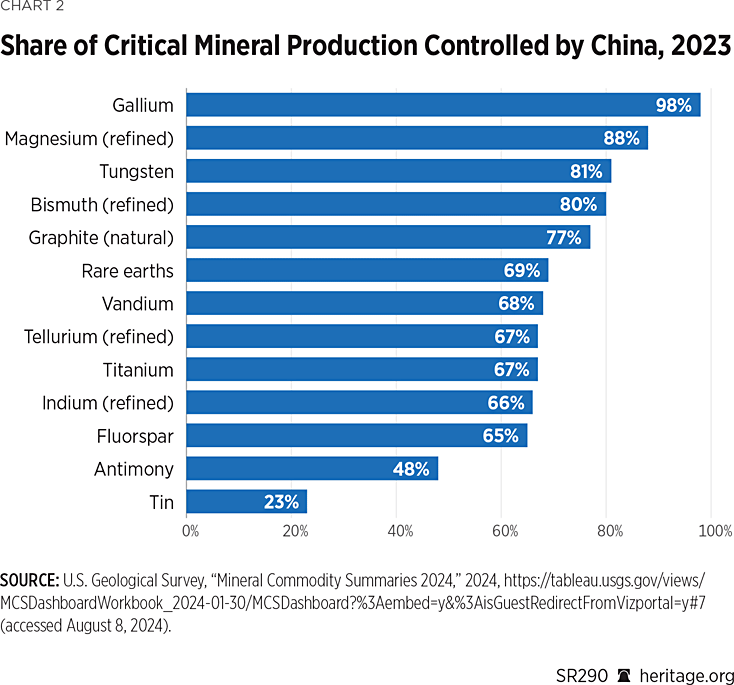
According to the International Energy Agency (IEA), if the projected green transition were to occur, the world would require a threefold to sevenfold increase in the global production of rare earth elements by 2040.REF Under current market structure, by far the largest portion of this increase would be controlled by China.
Permanent magnets account for 38 percent of the rare earth element market, the catalyst industry accounts for 23 percent, and alloys for batteries and metallurgy account for 17 percent. The largest category of magnets—the high-powered rare earth magnets (often a combination of neodymium, iron, and boron)—are used in 76 percent of offshore and 32 percent of land-based wind turbines.REF This technology structure has tied necessary inputs to the wind industry directly to the CCP.
Additionally, the IEA expects a fortyfold increase in the demand for lithium by 2040 as part of the green transition.REF China today produces around half of the lithium carbonate needed by global industry, and the CCP is purchasing large stakes in lithium mines in African countries such as Zimbabwe.REF
According to the Griffith Asia Institute at Australia’s Griffith University, the CCP’s Belt and Road Initiative (BRI) increased its “engagement” in technology, such as batteries, EVs, car parts, and telecommunications manufacturing, by 1,046 percent and its “engagement” in mining and metal refining by 158 percent between 2022 and 2023.REF For example, the BRI has been investing in lithium mines in Mali, lithium processing in Zimbabwe, copper processing in Saudi Arabia, nickel mines and solar cell factories in Indonesia, and EV factories in Thailand. These expenditures by GGFs and Chinese industry not only provide inputs to China’s domestic supply chains, but also provide resources for the Biden–Harris Administration’s green energy projects.
By contrast, similar projects in the United States take more time to acquire permits and finish the required environmental impact statements. For example, new American mines take an average of 16.5 years to move from discovery to development, even though the actual construction takes only five years of that time, according to the IEA.REF
China has recently banned exports of graphite, gallium, and germanium as well as technologies used in rare earth extraction and separation.REF The CCP may be pulling ahead in a number of sectors, such as solvent extraction technology for rare earth elements, which will increase its capacity for large-scale rare earth element extraction.REF If these technological advances come to fruition, China will gain a strategic advantage in refining future critical mineral deposits.
Access to Critical Minerals Blocked by the Biden–Harris Administration. Unfortunately, the Biden–Harris Administration has held up several critical minerals projects in the United States because of Environmental Protection Agency rules and regulations. The blocking of copper and nickel mining is likely illegal now that the Supreme Court has rolled back agency actions that depart from written statutes,REF and such illegality is especially troubling when one considers that the Biden Department of Energy’s July 2023 Critical Minerals Assessment characterizes these two minerals as critical to electrification in the medium term.REF
The Biden–Harris Administration has restricted access to critical minerals in the United States, most recently by blocking the Ambler Road Copper Mine in Alaska.REF The following projects were blocked in 2023:
- The EPA blocked the copper-rich and gold-rich Pebble Mine in Alaska.REF
- The EPA stalled a copper-rich and nickel-rich Twin Metals Mine in Minnesota with a 20-year moratorium despite the looming closure of the last American nickel mine in 2025.REF
- The EPA lobbied the Army Corps of Engineers to block another copper and nickel New Range Mine in Minnesota, citing mercury being released into rivers, despite the mining company’s plan to clean up a wastewater pond from a defunct iron mine as well.REF
- President Biden unilaterally declared that a million acres of public lands in northern Arizona would become a national monument, blocking the extraction of radionuclides such as uranium.REF

Chart 3 shows that both applications to mine and approvals to mine declined substantially during the Administrations of Presidents Barack Obama and Joe Biden. In 2011, companies submitted 72 applications for mines to the Bureau of Land Management, which approved 37. By 2015, applications had declined to 33 and approvals to 22. Applications rose to more than 40 during the Trump Administration, but by 2022, applications were at 14 and approvals at six.
The only bright spot for domestic mining in recent years has been the restarting of the rare earth Mountain Pass Mine in California that was shut down in 2002.REF Today, that mine produces about 15 percent of global rare earths but ships most of the ores to China for processing because of a lack of the necessary infrastructure in the United States.REF
China’s Growing Dominance in Batteries and Electric Vehicles
The story of China’s rising dominance in EVs is inseparable from the success of China’s battery industry because batteries make up around a third of the cost of EVs.REF Chart 4 shows that China produced 85 percent of the world’s electric batteries in 2023, and Chart 5 shows that production of the EV battery components is dominated by China. A lithium-based battery’s cathode needs such minerals as phosphorous, cobalt, manganese, or nickel, and the anode needs either natural or synthetic graphite. China controls 82 percent of the world’s mining of the natural graphite used in these battery anodes.REF
In addition, copper is increasingly vital to the manufacturing of electric batteries, and China controlled “more than 44 percent of global refined copper production” in 2023.REF Since EVs contain four times more copper than is required for gasoline-powered automobiles,REF this refined copper production is largely going to the production of EVs. An International Energy Forum study by Cornell University Professor Emeritus Lawrence Cathles and University of Michigan Professor Adam Simon concludes that “[t]o electrify the global vehicle fleet requires bringing into production 55% more new mines than would otherwise be needed.”REF
China controls 72 percent of lithium refining, 53 percent of phosphate refining, and 68 percent of cobalt refining capacity.REF These critical rare earth elements are also necessary for producing cathodes in batteries. The CCP has given the Chinese battery company Contemporary Amperex Technology Co. Ltd. (CATL), the largest such company in the world, funding to control 25 percent of the cobalt reserves in the Republic of Congo in Africa, where forced labor and child labor are used in the mining of cobalt for batteries.REF
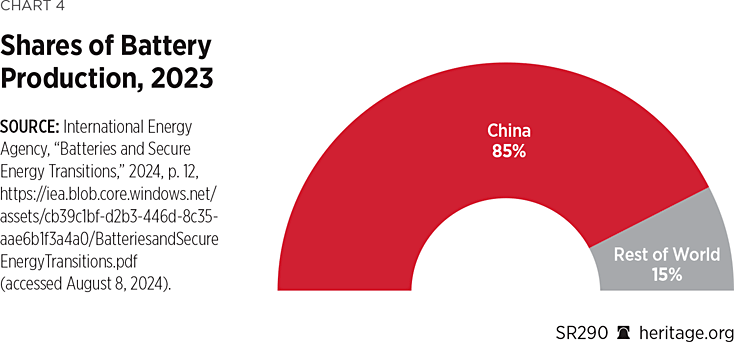

Chart 6 shows that China produces 66 percent of EVs, while Europe produces 22 percent and the United States produces only 10 percent. The Chinese Communist Party has subsidized its domestic EV market by $28 billion between 2009 and 2020 and plans to spend another $72 billion between 2023 and 2026.REF These subsidies include sales tax exemptions, R&D grants, and infrastructure subsidies. Many Chinese companies were incentivized to enter the battery industry because of these subsidies. Although a number of these companies failed, the creation of the first Tesla gigafactory in China gave others access to the Chinese-dominated supply chains that would be needed to make companies internationally competitive.
In addition to subsidizing EVs, the CCP penalized the use of gasoline-powered vehicles. Chinese cities required owners of vehicles with internal combustion engines to bid tens of thousands of dollars for license plates and to drive only on certain days of the week.REF In contrast, owners of EVs generally get free license plates, can drive at any time, and are tax exempt.REF By spurring domestic EV growth, China ensures that its domestic auto market will shift to EVs. This builds up domestic manufacturing, which results in economies of scale.

Moreover, China is building an ecosystem of technology around its batteries and charging stations for EVs. As has taken place in the past, China may be trying to use the technology to steal data from foreigners visiting areas domestically and abroad such as military bases, industrial sites, and government facilities by gathering data from the vehicles that use its charging stations.REF
For example, batteries produced by CATL, a recipient of CCP government guidance funds, were installed as backups to a solar array close to Camp Lejeune, North Carolina, home to the Marine Corps Special Operations Command. The base was forced to remove these batteries after Senator Marco Rubio (R–FL) and two dozen other Republican lawmakers sent a letter to Secretary of Defense Lloyd Austin demanding an investigation.REF The Senators were concerned that passive sensor technology in batteries could send data back to China and reveal the base’s energy demands during military exercises.REF
According to the Foundation for Defense of Democracies, CATL has ties to Beijing’s United Front Work Department.REF The department runs the All-China Federation of Industry and Commerce overseas trade group, whose vice chairman, Zeng Yuquan, is the company’s largest shareholder.REF Such a deeply intertwined relationship indicates clearly that companies such as CATL are not only corporate entities, but also instruments of state policy and intelligence gathering. At a minimum, these ties between the CCP and Chinese EV and battery companies call into question the wisdom of allowing imports of these vehicles into the United States.
China’s Growing Dominance in Renewables
Coal-Powered Renewables that Won’t Stop Climate Change. In their pursuit of an absolutist climate agenda, climate alarmists have ignored the threat posed by China’s dominance of the production of renewable components. They have ignored China’s abysmal environmental record and economic manipulation, advocated for U.S. subsidies for renewables, and restricted the development of mines within America. At the same time, U.S. companies are purchasing solar panels made with slave labor in China and driving Chinese electric vehicles with components that are produced using coal-fired power plants. In 2022, China permitted, on average, two coal-fired power plants a week, partly to supply power to battery and solar component factories.REF
China also produces 2,000 tons of toxic waste for every ton of rare earths elements extracted.REF The environmentally destructive ways China has extracted critical minerals have contributed to China’s loss of forested land. From 2000 to 2023, China lost 7.4 percent of its tree cover, and from 2002 to 2023, it lost 4.7 percent of its primary forest.REF The Lowy Institute estimates that due to industrial activity, 80 percent to 90 percent of the groundwater is no longer suitable for drinking, and almost 50 percent of aquifers contain water that is not fit for farming or industry.REF
The federal government’s Model for the Assessment of Greenhouse Gas Induced Climate Change shows that complete elimination of American carbon emissions would reduce global temperatures by only two-tenths of one degree Celsius by 2100.REF This is because Asia, Africa, and Latin America are not reducing their emissions. China produces more than 30 percent of the world’s annual greenhouse gases; America accounts for only 14 percent.REF China, along with the rest of the world, has rapidly been adding to global CO2 emissions; U.S. emissions have declined by 1,000 million metric tons in the past 15 years, largely due to the replacement of coal power plants by combined-cycle natural gas plants.REF According to Chart 7, China’s CO2 emissions nearly doubled those of the U.S. in 2022.
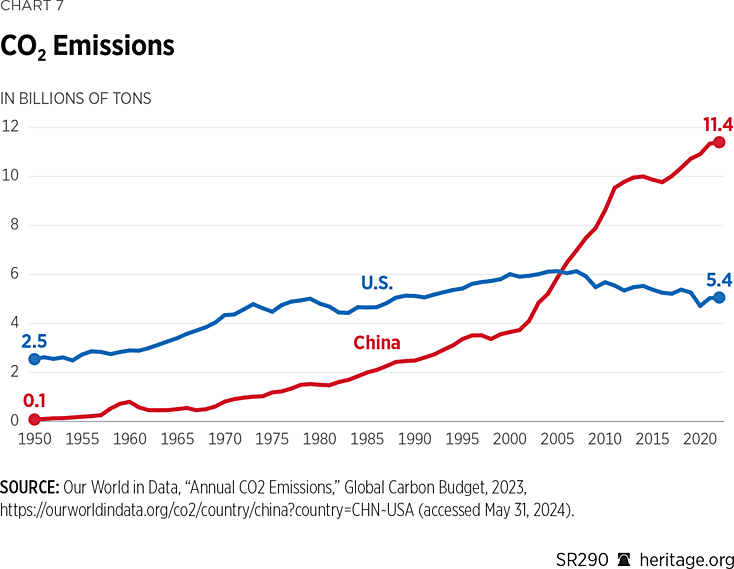
Even if Western countries decided not to import renewable energy, China plans to deploy four times more renewable energy capacity than the European Union (EU) and five times more than America from 2023–2028.REF China claims that by 2030, “almost half” of its energy will be produced by renewables,REF but China has a record of broken promises. In 2023, for example, CCP General Secretary Xi Jinping announced that China’s carbon emissions would no longer peak in 2030 as China had previously promised when it signed onto the Paris Agreement.REF
Solar: An Industry Exploiting Forced Labor. There are often challenges to connecting solar arrays to electrical grids because of the difficulties of transmission. In order to make solar more attractive, China has subsidized solar investments by approximately 50 percent to 70 percent.REF America has tried to match Chinese solar investment with a 30 percent tax credit.REF From 2014–2021 (the years for which the most recent data are available), the Chinese government provided almost $50 billion in subsidies to solar projects. This expenditure weakened the Chinese economy but allowed Chinese manufacturers to capture over 70 percent of the global market share.REF
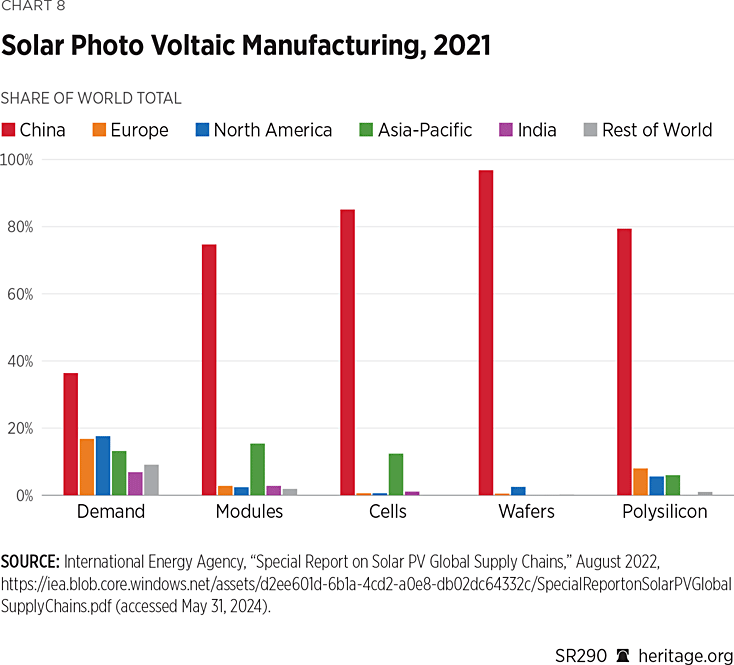
China currently dominates the solar supply chain. The International Energy Agency concluded in 2022 that “China’s share in all the manufacturing stages of solar panels (such as polysilicon, ingots, wafers, cells and modules) exceeds 80%. This is more than double China’s share of global PV demand.”REF However, China uses forced labor to manufacture potentially 79 percent of polysilicon, 97 percent of wafers, 75 percent of modules, and 85 percent of solar cells used in the solar industry.REF This reduction in cost has allowed China to dominate the industry, as shown in Chart 8.
The United Nations,REF the EU,REF the U.S. Department of Labor,REF and the U.S. Department of State have published reports about the use of forced labor in industries that are tied to renewable energy supply chains.REF The Center for Strategic and International Studies estimates that more than a million minorities, chiefly Uyghurs, Kazakhs, and Kyrgyz—defined by China as “surplus labour” according to the United Nations Office of the High Commissioner for Human RightsREF—have been subjected to mass detention, pervasive surveillance, and forced labor.REF
In its bid to dominate solar panel production, China has forced these “surplus” workers to labor in four of the world’s five largest polysilicon factories and in coal-fired power plants.REF This exploitation is one reason why China’s share of global polysilicon production rose from 62 percent in 2016 to 83 percent in 2022. America’s share declined from 35 percent to 5 percent over the same period.REF
Not only have buyers of solar panels been indirectly funding companies that use slave labor, but American taxpayers have also subsidized almost $37 billion in purchases between 2016 and 2022.REF The U.S. Department of Energy has calculated that without components sourced from forced labor in China, the cost of solar components could rise by 30 percent to 40 percent.REF
In 2021, in response to these labor practices, Congress passed a law signed by President Biden, popularly known as the Uighur Forced Labor Act, which prohibited imports of solar components made with slave labor.REF However, the U.S. Department of Commerce reported that China was shipping solar components made with forced labor to Cambodia, Thailand, and Vietnam, where they would be assembled and then sent to America as the products of these countries to avoid the import prohibition.REF Collectively, these three countries plus Malaysia, which is not engaging in the practice, now account for 80 percent of U.S. panel supplies.REF Trina Solar, which used Solar World’s technology in PERC solar cells, was found to be operating in Thailand.
Transmission and Wind: Further Dependence on China. With more than 1,080 gigawatts (GWs) of solar and 366 GWs of wind waiting to connect in 2023, the U.S. had a significant backlog of subsidized renewable projects, often permitted to build in remote areas where land is plentiful.REF However, construction in such locations necessitates a large build-out in expensive transmission infrastructure. These projects often take decades to complete and are highly dependent on large, globe-spanning supply chains.
For example, 82 percent of large power transformers come from abroad, according to the U.S. Department of Energy.REF Additionally, the Department of Energy found that the Asia-Pacific region accounts for 39 percent of market share by revenue.REF These large power transformers are used mostly by the wind industry to transmit electricity from rural areas to urban centers.
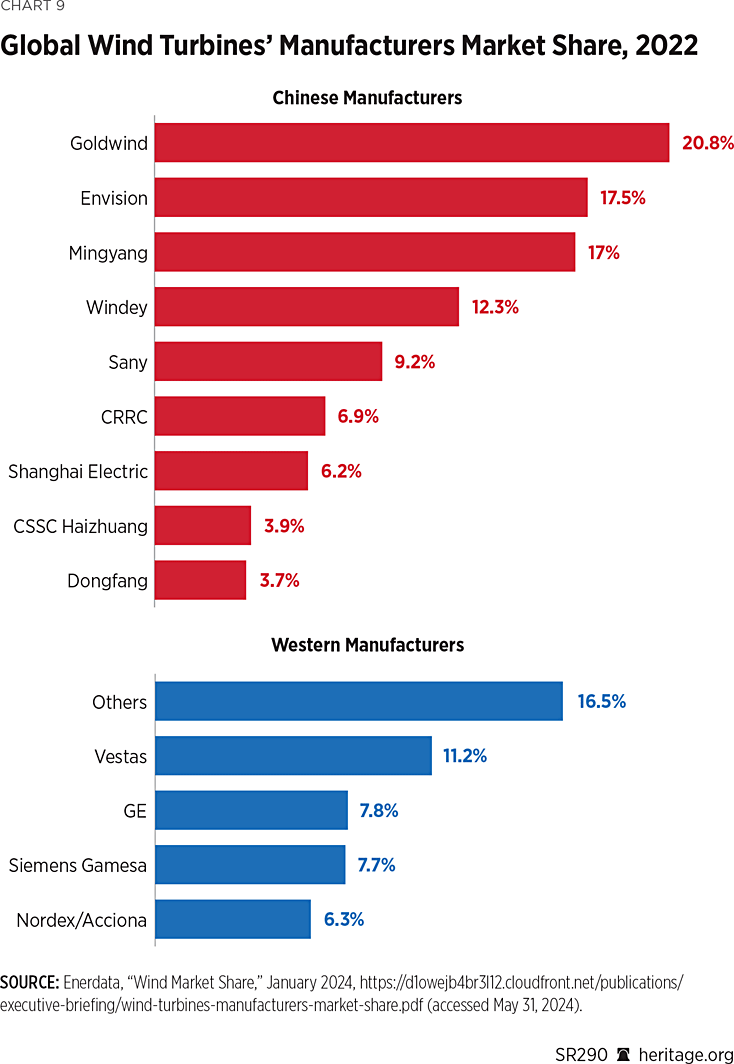
Chart 9 shows that China has a 66 percent market share in the global wind turbine market. With such a high market share, China holds a dominant position in the wind industry. Since 76 percent of offshore and 32 percent of land-based wind turbines use rare earth permanent magnets, China’s dominance in rare earths has also contributed to its disproportionate control of the wind industry.REF
Policy Recommendations
The forced transition to renewable energy and electrified transportation is weakening America and helping China. The obvious solution is for America to remove requirements and subsidies to use these technologies and instead let individuals, companies, and utilities decide on their preferred technologies. A level playing field would get rid of many of the problems described in this Special Report.
Regardless of whether or not America’s leadership continues with a forced transition to electric and renewable technology, federal and state politicians should allow, not block, domestic development of the critical minerals required for U.S. production. The current policy of requiring wind, solar, and electrification of vehicles and appliances while banning production of their essential inputs leaves America dependent on China.
China has created a cost advantage in producing renewables, batteries, and electric vehicles. The government of China has a stake in every major Chinese company and artificially sets prices and production targets. Chinese wage rates are disproportionately low due to forced labor. The cost of energy is lower because the CCP has not implemented many of the clean air requirements implemented in America and Europe. Xi Jinping has specifically abandoned his former pledge to peak Chinese emissions in 2030 and then reduce them thereafter. The cost of capital is lower because the CCP awards loans at favored rates to important companies. And this is just the tip of the iceberg, as the CCP subsidizes these companies in numerous other ways.
In addition to its cost advantage, China has made strategic purchases of foreign assets in order to develop its portfolio of critical minerals. The combination of cost advantage and access to critical minerals enables China to dominate global markets.
China is not forcing America to purchase its products, but America is making itself dependent on China by choosing to use federal and state regulations to require that the United States and individual states use renewable energy and electric vehicles. This reduces jobs for American workers and increases jobs for Chinese workers. It slows U.S. economic growth because green energy is more expensive than oil, gas, coal, and nuclear. It sacrifices American national security interests because China is not an American ally, and it is therefore unwise to depend on China for a vital section of the American economy.
Below are a series of steps that would allow America to free itself from its Chinese handcuffs, abandon mandates that encourage the use of Chinese products, and make use of America’s own domestic resources of oil and natural gas, as well as radionuclides.
- Refuse to engage in an unwinnable subsidy war and repeal all green tax subsidies and credits. This will enable a more rational choice of forms of energy and choice of vehicles and appliances. Subsidies and credits are an inefficient use of funds, raise the deficit, and slow the U.S. economy. Repealing all credits and subsidies, including recent credits and subsidies in the IRA, would reduce incentives to invest in green industries rather than America’s abundant hydrocarbon and power-dense nuclear industries.
- Permit domestic mining and processing of critical minerals. Whether or not the United States stops subsidizing the renewables industry, federal agencies should expedite mining and refining permitting to encourage these supply chains to onshore. Because domestic supply chains are easier to monitor, America will ensure that only friendly or allied countries create materials used for its high- tech and defense industries.
- Repeal onerous environmental regulations that prevent the expansion of domestic mineral, radionuclide, and hydrocarbon extraction and processing. By repealing onerous regulations, America can ensure that the material is assuredly extracted and refined according to proper labor and environmental conditions. Overtly tightening environmental standards will only drive these processes into other countries that will forgo our environmental and labor standards. Any future Administration should reduce this burden so that domestic mining, extraction, and refining can grow.
- Expand memoranda of understanding and trade deals with the Global South to secure fair market access to their resources. Beyond securing our own domestic resources, America can rapidly decouple from China only by diversifying its supply chains of these critical minerals to other countries such as the Democratic Republic of the Congo, Mozambique, Angola, South Africa, Namibia, and Malawi. America needs a diplomatic Global South strategy that would work to our mutual benefit and should not allow China to colonize Africa and Latin America with unfair, disadvantageous, and exploitative conditions.
- Leverage America’s position at the World Trade Organization to change rules regarding self-determined developing nation status. The WTO must be reformed so that it accurately reflects the economic development of its members, starting with China. Furthermore, it must follow its mandate to resolve disputes quickly and adroitly without overt bias against the United States.
- Use Section 201, 232, and 301 tariffs to wean American industry from Chinese products and spur reshoring or nearshoring. Future Administrations must use the power of the executive to deal harshly with China’s overt machinations in attempting to dominate key U.S. industries. Increasing tariffs in these industries will signal both to other nations and to international companies the country’s continued resolute willingness to hold China accountable.
- Pass tax reform that allows for full and immediate expensing of equipment, R&D costs, and the cost of structures to encourage capital-intensive industries to return to America. By allowing companies to write off their investments immediately instead of taking the deduction over the functional life of the asset, America will increase its labor productivity and competitiveness against state-subsidized Chinese companies. Rather than the current biased system that favors Chinese-dependent green industries, these reforms will increase investment in all sectors, still including domestically sourced renewables and advanced manufacturing. The reform will also benefit other high capital-cost industries including nuclear power and domestic resource development and refining. By spurring such investment across the board, America will have true energy independence and lead the world in energy-intensive sectors, including data centers and AI computing.
- Place tariffs on goods or ban goods from Chinese firms with national or economic security concerns that have received government guidance funds and subsidies. Since China has used the subsidies to buy out foreign IP or give its domestic companies an advantage, America must react strongly. Chinese companies that have received GGFs could be deemed “entities of concern” and be prohibited from doing business with the United States.
Conclusion
By leveraging mechanisms within the WTO, stealing or co-opting IP from foreign companies, and buying out foreign companies with government guidance funds, China has succeeded in dominating the world’s supply chains in green energy products and components. If America continues to require the use of these green energy products, it will cede economic power to China, giving China control of American energy security. America is making itself weaker and China stronger by passing a set of laws and enacting regulations that benefit an adversary. Only by abandoning green energy and vehicle mandates and subsidies, making use of its own domestic oil and natural gas resources, and passing prudent trade, tax, and regulatory policy will America continue to be strong and energy-independent. Now is the moment.
Diana Furchtgott-Roth is Director of the Center for Energy, Climate, and Environment and the Herbert and Joyce Morgan Fellow in Energy and Environmental Policy at The Heritage Foundation. Miles Pollard is an Economic Policy Analyst in the Center for Data Analysis at The Heritage Foundation.




